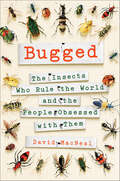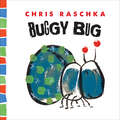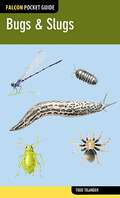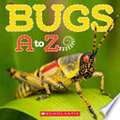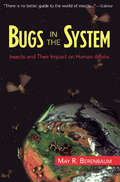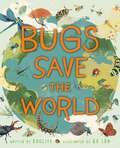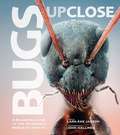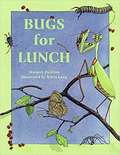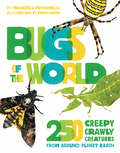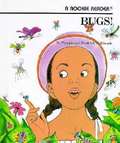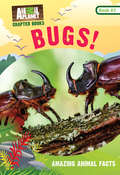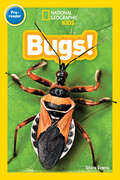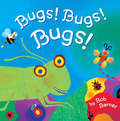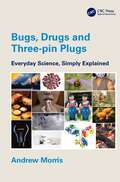- Table View
- List View
Bugged: The Insects Who Rule the World and the People Obsessed with Them
by David MacNeal"Creepy, beautiful, icky and amazing." —Penny Le Couteur, author of Napoleon's ButtonInsects have been shaping our ecological world and plant life for over 400 million years. In fact, our world is essentially run by bugs—there are 1.4 billion for every human on the planet. In Bugged, journalist David MacNeal takes us on an off-beat scientific journey that weaves together history, travel, and culture in order to define our relationship with these mini-monsters. MacNeal introduces a cast of bug-lovers—from a woman facilitating tarantula sex and an exterminator nursing bedbugs (on his own blood), to a kingpin of the black market insect trade and a “maggotologist”—who obsess over the crucial role insects play in our everyday lives. Just like bugs, this book is global in its scope, diversity, and intrigue. Hands-on with pet beetles in Japan, releasing lab-raised mosquitoes in Brazil, beekeeping on a Greek island, or using urine and antlers as means of ancient pest control, MacNeal’s quest appeals to the squeamish and brave alike. Demonstrating insects’ amazingly complex mechanics, he strings together varied interactions we humans have with them, like extermination, epidemics, and biomimicry. And, when the journey comes to an end, MacNeal examines their commercial role in our world in an effort to help us ultimately cherish (and maybe even eat) bugs.
Buggy Bug: Cowy Cow, Crabby Crab, Buggy Bug, And Clammy Clam (Thingy Things #3)
by Chris RaschkaTheme: Wanting attention. Buggy Bug has something to say. But what could it be? We may never know, in this pitch-perfect portrait of the inconsistencies of toddlerhood. Buggy Bug&’s insistence on attention—and then denial of attention—will prompt giggles upon each reading. Chris Raschka writes humor between the lines and paints in subtleties that will tickle readers of all ages. This is a fixed-format ebook, which preserves the design and layout of the original print book.
Bugle: A Dog of the Rockies (Famous Dog Stories)
by Thomas C. HinkleBugle was only a pup that first time he tangled with One Toe, the notorious rogue bear. His valiant mother Queen fell in the midst of that savage fight to the death. And from that day on the big powerfully built wolfhound never stopped in his hunt for the monster grizzly—even when the trail led him farther and farther away from the ranch and his young, pretty owner, Mary Norman. Caught and beaten by Lute Boggs, a crafty down-and-out trapper, Bugle almost starved to death. In a desperate effort to break away, the courageous dog was stung by the sudden strike of Lute's bullet. Yet Bugle was to escape at least when the treacherous Lute was struck down by the maddened One Toe. Bugle struck out on the trail of the grizzly once again, but was himself plagued by all the natural enemies of the timberland. But blizzards and the threat of wolves and mountain lions could not hold back Bugle from his destined showdown with One Toe. And when it came out was a bloody fight as the two teetered on the edge of a high cliff. Thomas Hinkle once again succeeds in capturing the spirit of the West in his tale of a magnificent wolfhound named Bugle.
Bugs & Slugs (Falcon Pocket Guides)
by Todd TelanderFalcon Pocket Guide: Bugs & Slugs is a field guide to 100 of the most common and sought-after bug and slug species in the region. Anatomically correct illustrations and detailed descriptions about each insect's prominent physical attributes and natural habitat make it easy to identify bugs and slugs in your backyard, favorite parks, and wildlife areas. Informative and beautiful to peruse, this is the essential resource when you're out in the field.Falcon Pocket Guides are full-color, visually appealing, on-the-go guides for identifying plants and animals and learning about nature.
Bugs (Be an Expert!)
by Erin KellySome crawl. Some jump really high. Some have beautiful wings! What do you know about bugs? With this book, you can become an expert!Kids love to be the experts! Now they can feel like real pros with this exciting nonfiction series for beginning readers. Kids will be hooked on the thrilling real-world topics and big, bright photos. Each book features simple sentences and sight words that children can practice reading. Then, with support, kids can dig deeper into the extra facts, Q&As, and fun challenges.Fans of this series will be eager to become real experts!
Bugs A To Z
by Caroline LawtonAn essential A to Z bug book for young readers. The perfect book for all kids who are fascinated with bugs. Simple text from A to Z provides buggy facts and figures. Larger than life full-color photographs of creepy crawlies include locusts, caterpillars, beetles, flies, grasshoppers, ants, praying mantis, and more!
Bugs Bunny Goes to the Dentist
by Seymour ReitBugs Bunny has to write a poem for HAPPY TEETH WEEK and he needs some help so he goes and visits the Dentist.
Bugs Don't Hug: Six-Legged Parents and Their Kids
by Heather L. MontgomeryMeet the mamas and papas of the insect world in this fresh and funny nonfiction look at how bugs are like us from popular science author and teacher Heather Montgomery.Most insects don't take care of their young, but some do--in surprising ways. Some bugs clean up after their messy little ones, cater to their picky eaters, and yes--hug their baby bugs. A fun and clever look at parenting in the insect world, perfect for backyard scientists and their own moms and dads. Back matter includes further information about the insects and a list of resources for young readers.
Bugs In The System: Insects And Their Impact On Human Affairs
by May R. BerenbaumAn introduction to insect physiology, genetics and behaviour which looks at the interaction between humans and insects, and explores both the positive and negative aspects of the relationship.
Bugs Rule!: An Introduction to the World of Insects
by Richard Redak Whitney CranshawThe essential illustrated introduction to insects for nonscience majorsBugs Rule! provides a lively introduction to the biology and natural history of insects and their noninsect cousins, such as spiders, scorpions, and centipedes. This richly illustrated textbook features more than 830 color photos, a concise overview of the basics of entomology, and numerous sidebars that highlight and explain key points. Detailed chapters cover each of the major insect groups, describing their physiology, behaviors, feeding habits, reproduction, human interactions, and more.Ideal for nonscience majors and anyone seeking to learn more about insects and their arthropod relatives, Bugs Rule! offers a one-of-a-kind gateway into the world of these amazing creatures.Places a greater emphasis on natural history than standard textbooks on the subjectCovers the biology and natural history of all the insect ordersProvides a thorough review of the noninsect arthropods, such as spiders, scorpions, centipedes, millipedes, and crustaceansFeatures more than 830 color photosHighlights the importance of insects and other arthropods, including their impact on human societyAn online illustration package is available to professors
Bugs Save the World
by BuglifeFind out why bugs are so important - to humans, animals and the survival of our planetOur amazing bugs are in trouble. Without bugs, plants would not be able to make flowers or fruit. If bugs disappeared, so would strawberries, apples, beans and tomatoes, and even chocolate. Without them, we couldn't grow enough food to feed us all. If we lost bugs, we would also lose creatures who depend on them for survival, such as songbirds, badgers, bats and fish.Written by the conservation charity Buglife, this book shows the reasons why bugs are so important - to humans, animals and the survival of our planet. Discover bugs in all shapes, sizes and colours, and learn how these tiny creatures are going to help SAVE the world. You can also discover what you can do to help protect bugs. Buglife, the Invertebrate Conservation Trust, is dedicated to protecting insects, bugs and all invertebrate species.This book supports science work in schools by looking at different animals, adaptation, food chains, life cycles, habitats and climate change.In the accompanying book, Plants Save the World, you can discover why plants are vitally important to the survival of our planet, too!
Bugs Up Close: A Magnified Look at the Incredible World of Insects
by Lars-Åke Janzon John HallménBugs are usually so small that we hardly notice them, let alone think of them as living beings. But call upon the magnifying glass, and a shapeless jumble of legs, wings, and antennae suddenly start staring back at us.About 80 percent of the Earth's animals are insects. While there are millions of different species, we rarely see many of them . . . until now. Thanks to the photography of John Hallmén, who took a camera and magnified these magnificent creatures one hundred times, we can see what we've never been able to see before.Bugs Up Close takes readers on a journey into a world rarely seen, with incredible photographs of such insects as:Crane fliesYellow meadow antsBlack fungus beetlesTreehoppersAnd many more!The diversity of this insect civilization is striking and unknown to most. An insect we may never have thought twice about now looks like a creature from outer space. Fascinating and somewhat monstrous details such as compound eyes, antennae, and sharp mouth parts are visible, and with text by Lars-Åke Janzon, Bugs Up Close is an amazing close look into the strange and beautiful world of insects.
Bugs for Breakfast: How Eating Insects Could Help Save the Planet
by Mary BooneMost North Americans would rather squish a bug than eat it. But roasted grubs are a favorite in Australia, the Batswana eat live termites, and stir-fried dragonflies are a delicacy in Indonesia. More than one-fourth of the world's population eats insects—a practice called entomophagy. Bugs for Breakfast helps middle-grade readers understand the role insects fill in feeding people around the world. Readers will be introduced to the insect specialties and traditions of various countries. They'll discover how nutritious bugs can be and why dining on insects is more environmentally friendly than eating traditional protein sources. Kids will see how making small changes in their own diets could help ensure no one goes hungry. It even includes 12 insect recipes! No doubt about it: teachers, librarians, and parents are hungry for books that entice young readers to be active participants in science.Bugs for Breakfast may not completely remove the yuck-factor from the notion of eating bugs, but it will open young readers' minds to what is happening in the world around them.
Bugs for Lunch (Fountas & Pinnell LLI Blue #Level J)
by Margery Facklam Sylvia LongDiscover the variety of bug-eaters—animal, plant, even human—in this exploration of both poetry and the natural world. Facklam’s playful rhymes mixed with Long’s vivid illustrations introduce young readers to an array of creatures as they munch on lunch. From a mantis perched and ready to prey on ladybugs, a spider trapping a fly, to the honey-drenched fur of a big brown bear chewing on a hive full of bees, Bugs for Lunch will give curious readers plenty of food for thought delivered in a playful package.
Bugs of the World: 250 Creepy-Crawly Creatures from Around Planet Earth
by Francesco TomasinelliFrom moths and beetles to worms and spiders, this completely illustrated, fact-filled book features hundreds of creepy-crawlies for kids to discover and explore.This gorgeously illustrated book reveals the hidden world of some of the most mind-boggling insects. Divided into categorical sections like herbivores and predators, Bugs of the World includes beetles, wasps, bees, ants, caterpillars, butterflies, dragonflies, spiders, flies, crickets and grasshoppers, centipedes and millipedes, and more. Each of the 250 insects featured is accompanied by beautiful illustrations and facts about the creature, including its common name and scientific name, its size, its continent of origin, and a brief description of its unique characteristics. Kids will also learn about the different life cycles of insects, why they are important to ecology and our world, the planet's most dangerous insects, how bugs camouflage themselves, and so much more.
Bugs!
by Patricia C. Mckissack Fredrick L. MckissackSimple text on a variety of insects introduce the numbers one through five.
Bugs! (Animal Planet Chapter Book #3)
by James Buckley JrFrom grasshoppers to cicadas and the deadly black widow spider, this accessible narrative is packed with full-color photos and fascinating information about every kid's favorite subject. Bug profiles highlight facts and figures about insects around the world, "Fact File" features go in-depth on important animal biology features, and "In Your Newsfeed" teaches readers about breaking news in the field. Packed with information for thrill-seekers and animal lovers alike, this is the perfect book for new readers who are ready to take a deeper dive into their favorite subject.
Bugs! (Animal Planet Chapter Books #3)
by James Buckley Jr Animal PlanetAnimal Planet introduces information-packed nonfiction chapter books that are just right for pleasure reading and schoolwork. <p><p> Fly away on a fascinating journey to the world of Bugs!. Meet the fastest flyers and the long-distance travelers--from huge moths and colorful butterflys to busy bees and annoying fleas. Learn about massive locust swarms and hungry caterpillars. Bugs! is the perfect overview for developing readers ready to explore this popular animal subject on their own. Special features include full-color photography throughout, "Meet the Scientist" sidebars, and "In Your Newsfeed" articles about amazing new discoveries. <p> Don't miss the other books in the Animal Planet Chapter Books series: Snakes!, Dinosaurs!, and Sharks!.
Bugs! (Readers)
by Shira EvansYoung readers learn all about insects in this new Pre-reader from National Geographic Kids.Through text features such as a vocabulary tree and wrap-up activity, kids will be introduced to vocabulary in concept groups, helping them make connections between words and expand their understanding of the world. Along with brilliant photos and a fun approach to reading, National Geographic Readers are a winning formula with kids, parents, and educators.
Bugs! Bugs! Bugs!
by Bob Barner"Aspiring entomologists will develop a friendly, appreciative attitude toward the bugs they're most likely to encounter, and Barner's playful use of colors, shapes and words may even convert bug foes."--from Publisher's Weekly
Bugs! Bugs! Bugs!
by Bob BarnerPretty ladybugs, fluttering butterflies, creepy daddy longlegs, and roly-poly bugs are some of the familiar creatures featured in this whimsically illustrated insect album. Complete with an "actual size" chart and bug-o-meter listing fun facts about each bug, Bugs! Bugs! Bugs! will inform and entertain curious little bug lovers everywhere.
Bugs, Beware! (Into Reading, Level T #90)
by Lisa Klobuchar John Manos John KanzlerNIMAC-sourced textbook
Bugs, Drugs and Three-pin Plugs: Everyday Science, Simply Explained
by Andrew MorrisFor the millions who remain curious about the world around them, but gained little from science at school, this book offers a way forward. Based on live discussions with adults from all walks of life, each chapter begins with an everyday experience, like swallowing a pill or watching a bee on a flower. The main scientific ideas underlying each topic are then explored, so that understanding of a set of fundamental concepts builds up gradually throughout the book. In contrast to more traditional approaches to science learning, topics range freely across the subject areas. The story of Covid, for example includes aspects of biology, chemistry, mathematics and social behaviour. Plain English is used throughout and mathematical expressions are avoided. Key points are illustrated with clear diagrams and photographs. By drawing on questions and perspectives of ordinary people, the book offers an introduction to basic ideas in science as a whole, rather than any one particular subject. For the adult wishing to make good a gap in their understanding it provides a starting point for entering the rich world of popular science.
Bugs: Independent Reading Non-Fiction Pink 1a (Reading Champion #515)
by Katie WoolleyThis book is part of Reading Champion, a series carefully linked to book bands to encourage independent reading skills, developed with UCL Institute of Education (IOE)Bugs is a non-fiction text exploring how different bugs eat leaves. The repeated sentence structure offers readers the opportunity for a very first independent reading experience with the support of the illustrations.Reading Champion offers independent reading books for children to practise and reinforce their developing reading skills.This non-fiction text is accompanied by engaging artwork and a reading activity. Each book has been carefully graded so that it can be matched to a child's reading ability, encouraging reading for pleasure.
Bugwatching: The Art, Joy, and Importance of Observing Insects
by Eric R. EatonDiscover the pleasures of watching insects with this fun, informative, and marvelously illustrated how-to guideInsects are the most abundant wildlife on the planet—but also the least observed. This incisive field companion highlights the basic tools for watching insects with all of our senses, covers some best habitats and circumstances for seeing the most diversity, and shares tips for attracting desirable insects to your yard and garden. With wonderful illustrations by Samantha Gallagher, Bugwatching explains why this rewarding activity is for everyone, regardless of age, ethnicity, gender identity, level of affluence, ability, or disability. When you become a bugwatcher, you join a community of supportive and energetic people. The potential for personal and scientific discovery is virtually limitless.Enables you to better appreciate and understand insects and improve your success rate in finding, watching, and identifying themIncludes a comprehensive treatment of insect behaviors that is invaluable for beginnersDiscusses social bugwatching and participation in community science projectsCovers advanced topics such as rearing insects and using keys to identify themExplains how watching insects can fill gaps in our knowledge about their economic impacts and the growing decline in insect diversity and abundancePromotes safety, accessibility, and inclusion as vital aspects of watching insectsAn essential guide for seasoned bugwatchers and newcomers to the community
